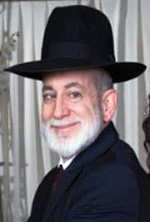Rabbi Yaakov Marks

SAN DIEGO — Have you ever been in a situation where there seemed to be no positive ending and maybe things got even worse than you thought they could and then your “luck” changed and you have this sense of liberty and you wanted to scream out thank you!? The Talmud brings four situations which people need to give thanks to G-d for redeeming them and they are a person who traveled over an ocean, someone who traveled in a wilderness, a person who was seriously ill and recovered, and someone released from a prison.
When the Temple was functioning, this feeling of gratitude was conveyed through the Thanksgiving offering. The Thanksgiving offering included forty loaves of bread, three types of unleavened matzah, ten of each type, and ten loaves of leaven bread. The ten leaven loaves had an equal amount of flour as the thirty matzah loaves. A portion was given as a gift to the officiating Cohen and the rest was eaten that day and into the night by the sponsor and his friends.
Many questions are raised about the procedure of this offering. Leaven is prohibited to be brought to the alter so why is it now required? In this category of offering two days and a night are available to consume the offering, why here does it have to be eaten that day and before the night is over? Why is so much bread required? Why do the ten leaven loaves weigh as much as the thirty matzah loaves?
There are several symbolic interpretations for “Chametz” (leaven). Chametz, souring of the dough, is symbolic of the danger or obstacle that “sours” our life. Whereas, the Matzah represents the good events that uplift our spirits. Chametz is also symbolic of independence a feeling of being in control. Matzah depicts modest prosperity which comes from G-d and is to be used in His service. Chametz is arrogance and Matzah is humility.
G-d made Chametz an integral part of the Thanksgiving offering to teach us that obstacles are an integral part of our life. They are not our fault, but carefully planned events to stimulate our growth. The equal measurement of flour for the Chametz and the Matzah shows us that obstacles and prosperity are equally required for personal growth. The thirty loaves of Matzah compared to the ten loaves of Chametz demonstrates that in reality the good consequences in our life are more numerous than the obstacles. The large amount of bread to be eaten and the short period of time forces the person to invite a lot of friends to his Thanksgiving meal. He will talk and be questioned about his experience. They will hear about his trials and tribulations and of his salvation. He will be released from his guilt and the listeners will be inspired or use him as an example to inspire others.
Through the offerings, G-d is revealing to us secrets of human nature and behavior. Many people feel it’s their fault when something bad happens and when it passes, they try to hide it. Others feel that they are the only one this bad thing happened to and can get depressed. G-d is telling us that obstacles are part of a learning process and are no one’s fault and nothing to be ashamed of. On the contrary, these experiences should be publicly shared to inspire and strengthen other people. They are not alone and they can also overcome. Some people need to see it is possible.
Hillel will obligate the poor and Rabbi Elazar ben Charsom will obligate the wealthy. They themselves will do no action to hurt anyone. That they were able to make time and be able to focus on their learning in their extreme poverty and abundant wealth shows us that it is possible. We have an example to follow and if we don’t, we have no excuse. Up until a short while ago it was a known “fact” that man could not run a four-minute mile. Then one person proved it was possible and thousands have followed his example.
May we have the merit to overcome our personal obstacle. May we have the strength to use our victory to show others they are not alone. May we be freed from our fears and be proud to be chosen by G-d to be the example to help others see it is possible!
*
Rabbi Marks is a life and health coach, who may be contacted via ahealthyrabbi@gmail.com. Comments intended for publication in the space below must be accompanied by the letter-writer’s first and last name and his/her city and state of residence (city and country if outside the U.S.)